Porcelain Insulator News
by Elton Gish
Reprinted from "Crown Jewels of the Wire", January 1998, page 18
In May 1997 Crown Jewels of the Wire, we discussed the Hewlett suspension
insulator and the Ohio Brass link strain insulator. Both styles of O-B link
strain were shown on page 24. The older version with the flat sides and
relatively sharp flange edges was shown in the 1912 O-B catalog and the more
common rounded version we call the "hog liver" or "pork
liver" insulator was shown in the 1919 O-B catalog. I got one of each type
at the Rosemont National show last July. The photograph below shows both
versions together and each has the embossed O-B marking. The "pork
liver" insulator has a typical black / tan mottled O-B glaze from the
1920's-1930's. The older version has a rather dark purplish mahogany glaze and
is very shiny. The two holes were carved out straight through rather than curved
as in the Hewlett design. The sides are crude as though someone carved away
excess clay all the way around. Note that there is a relatively sharp drip edge
on the top and bottom of the flat sides that extends away from the body of the
insulator. There are two flat areas on the bottom drip edge, which were unglazed
and acted as the firing rest.
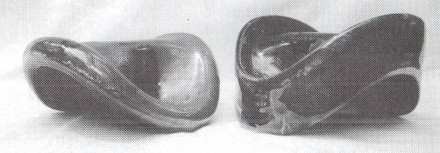
Two Ohio Brass link strain insulators: "pork liver" on left (7-1/2"
in
diameter) and earlier version on right (7-1/4" in diameter and 2"
flat sides).
Ed Sewall, Mike Spadafora, and Robin Harrison (NIA #1309) have made several
trips in the mountains east of Seattle at Steven's Pass where they have found
various broken early O-B link strain insulators along an old trolley line that
was part of the catenary system. They found a couple of early O-B link strain
insulators that had a beautiful orange glaze! This glaze color is the very
earliest of O-B glazes indicating the insulator was made soon after the Akron
High Potential Porcelain Co. was taken over by Ohio Brass in 1907. Remember the
Priestley patent for this insulator style was applied for in December 1910
(granted on October 1, 1912) so the orange-glazed insulators were made very near
that time period.
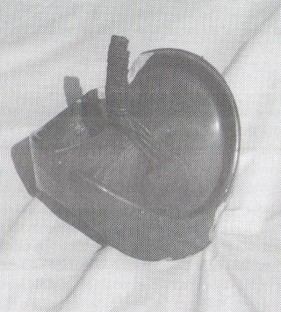
Older version of the O-B link strain with beautiful orange glaze.
Ed, Mike, and Robin also found another O-B insulator similar to the link
strain that was used in vertical suspension service on the catenary system.
Unlike the older link strain which has two drip edges on the 2" flat outer
surface, this insulator has only one drip edge that, when mounted vertically,
hangs down like an outer petticoat (just like on the older link strain). The
top outer surface is rounded with the body of the insulator. This insulator was
not shown in any of the Ohio Brass catalogs that I have but must be of the same
vintage as the other O-B link strains.
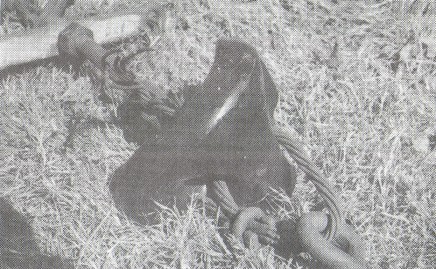
Odd type of O-B vertical suspension with only one drip edge.
I also got a couple of other unusual insulators at the Rosemont National show
that are similar to the Hewlett and O-B link strains. The first one is most like
the "fish-tail" Hewlett except the outer edge is slightly convex
(curved out). The outer edge surface of the 8" diameter wheel-shaped
insulator is 2-3/4" wide. The insulator has curved interlocking holes similar
to the Hewlett (not straight through like the O-B link strains). The glaze color
is metallic tan with a few blotches of black. This rather early looking
insulator has a sanded spot on the curved outer surface of the ring which was
used as a firing rest to fire the insulator vertically in the wheel position.
Oddly, the firing surface was not flat.
I didn't see this style of insulator in
any of my catalogs while researching the May PIN article. Quite by accident I
found this insulator described in my Pittsburg Export Catalog No. 20 (circa
1920). A copy of that catalog page is reproduced here. The only difference is
the catalog shows the outer surface to be 3" compared to 2-3/4" on the
specimen. We know that Pittsburg produced more styles than any other porcelain
manufacturer and they copied popular glass and porcelain styles made by other
companies. They evidently did not pass up the chance to copy the Hewlett
"fish tail" strain insulator. However, Pittsburg may have had second
thoughts about copying the popular Hewlett suspension insulator that was being
manufactured by General Electric, Thomas, and Locke. Then again, the Hewlett popularity was
mostly after Westinghouse took over the Pittsburg factory in 1922 and, too,
Pittsburg offered several cap and pin suspension insulator styles which were
easier to make.
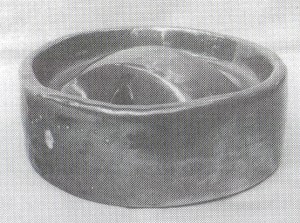
Pittsburg 8" diameter strain insulator.
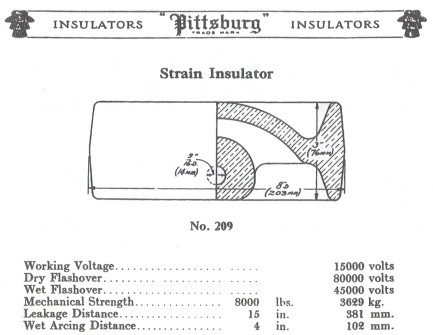
The second unusual strain insulator is only 6" in diameter. It is shaped
like a ball with a 1" ring around it and has two curved interlocking holes
like the Hewlett. The glaze color is mahogany with blotches of mustard
indicative of Thomas manufacture in the early 1910' s. I could not find this
insulator in Thomas catalogs from 1915, 1920 or any other year.

Early Thomas 6" strain insulator (left) and
7-1/2" Thomas "fish
tail" strain insulator.
Back to the lines around Steven's Pass east of Seattle, Ed, Robin and Mike
have also found numerous broken M-3070's that were cemented on Lee pins. Mike
found a piece of a broken crown with the marking, "LIMA, N.Y." The
glaze color and other characteristics indicated, too, that these were Lima
manufacture. After many trips searching the line they managed to find three or
four whole M-3070's in good condition but none of them have the Lima marking. In
addition, Mike found the two top unglazed portions of the middle shell that had
the following 1-3/16" diameter black ink stamp.

There will be more details
on their hunts in the mountains east of Seattle latter this year with an article
that will appear in Crown Jewels of the Wire. (See page 5 this issue, The
General Electric Company Porcelain Factory and the U-701 by Ed Sewall.

M-3070 N-N Lima found near Steven's Pass east of Seattle.
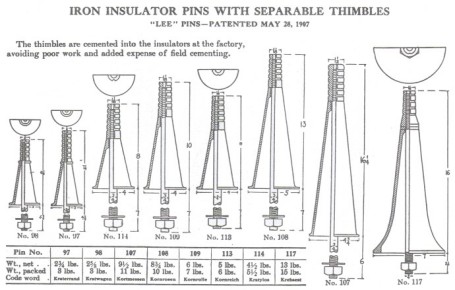
Various Lee pins was taken from the 1910 Locke
catalog.
| 